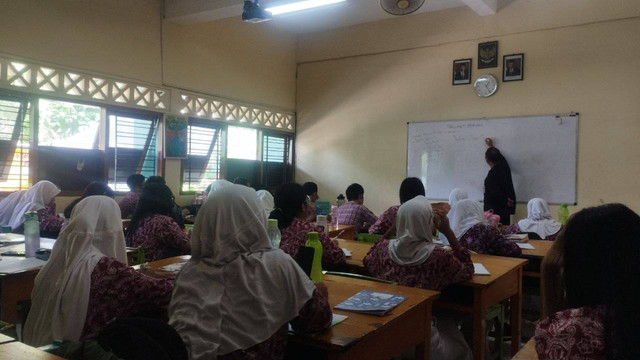Tentang KamiPedoman Media SiberKetentuan & Kebijakan PrivasiPanduan KomunitasPeringkat PenulisCara Menulis di kumparanInformasi Kerja SamaBantuanIklanKarir
2025 © PT Dynamo Media Network
Version 1.103.0
Konten dari Pengguna
Designing Differentiated Instruction in Mathematics
31 Desember 2024 9:46 WIB
·
waktu baca 6 menitTulisan dari Misbakhul Bahri tidak mewakili pandangan dari redaksi kumparan

ADVERTISEMENT
Differentiated instruction is an approach that adapts teaching to the needs, interests, and abilities of students. In mathematics learning, which is often considered a challenge by some students, the application of differentiated instruction is very important. This allows students with various abilities to learn optimally and feel more confident in mastering mathematical concepts. Here are the steps to design differentiated instruction in mathematics.
ADVERTISEMENT
1. Recognizing Student Diversity in the Classroom
The first step in designing differentiated instruction is to recognize the characteristics and needs of students. Each student has a different level of ability in mathematics; some quickly understand concepts, while others need more time and explanation. Using diagnostic assessments at the beginning of the lesson is an effective way to understand this diversity. You can use quizzes, pre-tests, or even short interviews to assess students' level of understanding of the material to be studied.
For example, at the beginning of the semester, a math teacher gives a diagnostic assessment on the concept of fractions. The results of this test provide an overview of the students’ abilities, so teachers can determine whether most students need reinforcement in basic fraction concepts or are ready to move on to more advanced concepts.
ADVERTISEMENT
2. Setting Flexible Learning Objectives
After recognizing the diversity of students, teachers need to set learning objectives that are achievable for all students, but with a flexible approach. Flexible learning objectives allow students with different abilities to learn in a way that works for them. This will give students the opportunity to achieve optimal results even though the paths they take are different.
For example, in the topic "Operation of Fractions", the learning objective could be: "Students can understand and apply the concept of operation of fractions." However, the way in which this objective is achieved can vary. Students with higher abilities can be given more complex problems, while students who need more support are given problems with a lower level of difficulty and use visual aids such as diagrams.
ADVERTISEMENT
3. Adjusting Learning Content
Each student has different needs in terms of the content they learn. In mathematics, this means teachers need to provide a variety of materials with different levels of difficulty. More advanced students can be given more challenging content, while students who are struggling can be given simpler material and accompanied by more detailed explanations or aids.
For example, when teaching "Linear Equations", more advanced students can be given problems involving systems of linear equations with two variables. Meanwhile, students who need more support can be given problems with one variable or simpler problems and given manipulatives or visualizations to help them understand.
4. Provide a Variety of Teaching Methods
Differentiated instruction also involves using a variety of teaching methods that are appropriate to the students' learning styles. Visual learners can be given graphs or diagrams, while students who prefer to learn kinesthetically can be encouraged to manipulate objects or use aids to understand mathematical concepts.
ADVERTISEMENT
For example, in a "Geometry" lesson, teachers can use a variety of approaches. Visual learners can be encouraged to draw geometric shapes and study their properties, while more kinesthetic learners can be encouraged to use props such as blocks or 3D geometric models to understand the concept.
5. Grouping Students Based on Needs
Teachers can dynamically group students based on their abilities. These groups are not fixed but can change according to the material being studied. By grouping students based on their needs, teachers can provide more targeted support.
For example, in the topic "Algebra", teachers can group students who are already proficient in algebraic operations to solve more complex problems, while students who need more help can be invited to work in small groups focusing on basic algebra exercises and provide them with direct guidance.
ADVERTISEMENT
6. Diverse Assessments
Assessment in differentiated instruction should be diverse, not only based on exams or tests but can also involve projects, portofolios, or task-based assessments. This allows teachers to more accurately measure student understanding and gives students the opportunity to demonstrate their understanding in ways that suit their strengths.
For example, in the topic "Statistics", teachers can give project assignments where students collect data, analyze it, and present their findings in the form of a presentation or written report. For students who prefer working with numbers, they can be given manual calculation problems or more technical problems, while students who prefer using technology can be asked to use statistical software for analysis.
ADVERTISEMENT
7. Using Technology to Support Learning
Technology provides a great opportunity to support differentiated instruction. Through the use of math applications or software, students can learn in ways that suit their needs, such as using video tutorials, educational games, or applications that help them visualize abstract math concepts.
For example, in the topic "Patterns and Sequences", teachers can use applications such as "Geogebra" to let students draw patterns or sequences and explore different variations of patterns. More visual students can use the app to see a graphical representation of the concept, while other students can work with paper problems or use manipulatives to understand the sequence.
Designing differentiated instruction in math helps create an inclusive and effective learning experience by tailoring instruction to the different needs and abilities of students. By following steps such as recognizing student diversity, setting flexible goals, adapting content, and offering a variety of teaching and assessment methods, teachers can help students reach their potential in math. Differentiated instruction gives students the opportunity to learn in a way that works for them, which can improve their overall understanding and skills in math.
ADVERTISEMENT
References:
Andrade, H. L., & Cizek, G. J. 2019. Handbook of Formative Assessment. Routledge.
Brillante, A., & Jablonski, M. 2020. Differentiated Instruction: Meeting the Diverse Needs of All Students. Routledge.
Lee, M., & Choi, H. 2022. The Role of Technology in Differentiated Learning. Computers & Education, 178.
Subban, P. 2016. Differentiated Instruction: A Research Basis. International Journal of Education.
Tomlinson, C. A., & Imbeau, M. B. 2017. Leading and Managing a Differentiated Classroom. ASCD

